Child Development and Cognitive Growth
VerifiedAdded on 2020/10/05
|10
|3064
|166
AI Summary
This assignment covers various aspects of human development, including child psychology, cognitive growth, and the impact of environmental factors such as green spaces and socioeconomic conditions on childhood development. It also explores the effects of selective serotonin reuptake inhibitors during pregnancy on behavioral, emotional, and social development in preschool-aged children. The assignment includes a range of topics from early temperament to language development in children with speech and language impairments.
Contribute Materials
Your contribution can guide someone’s learning journey. Share your
documents today.
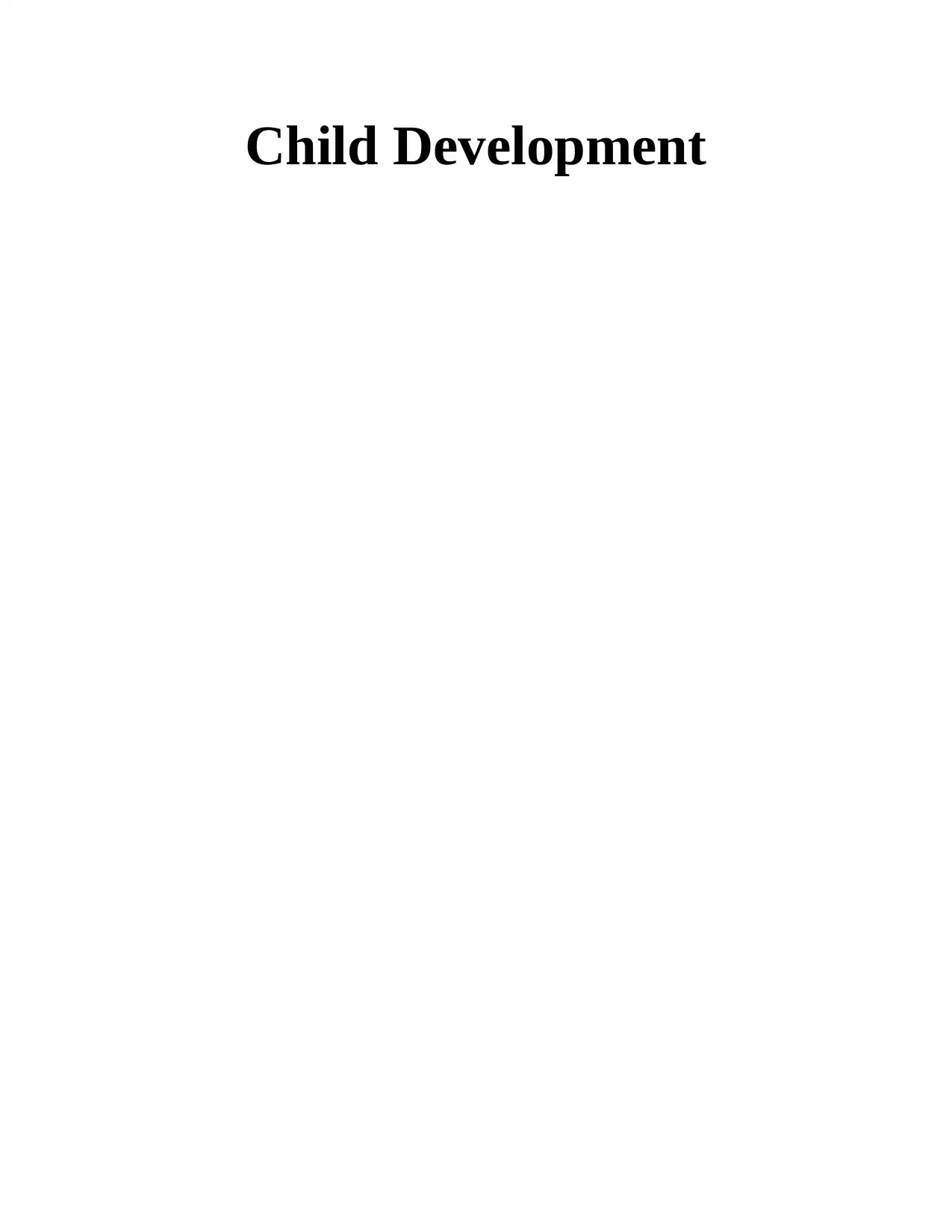
Child Development
Secure Best Marks with AI Grader
Need help grading? Try our AI Grader for instant feedback on your assignments.

Table of Contents
INTRODUCTION...........................................................................................................................1
CONCLUSION................................................................................................................................6
REFERENCES................................................................................................................................7
INTRODUCTION...........................................................................................................................1
CONCLUSION................................................................................................................................6
REFERENCES................................................................................................................................7
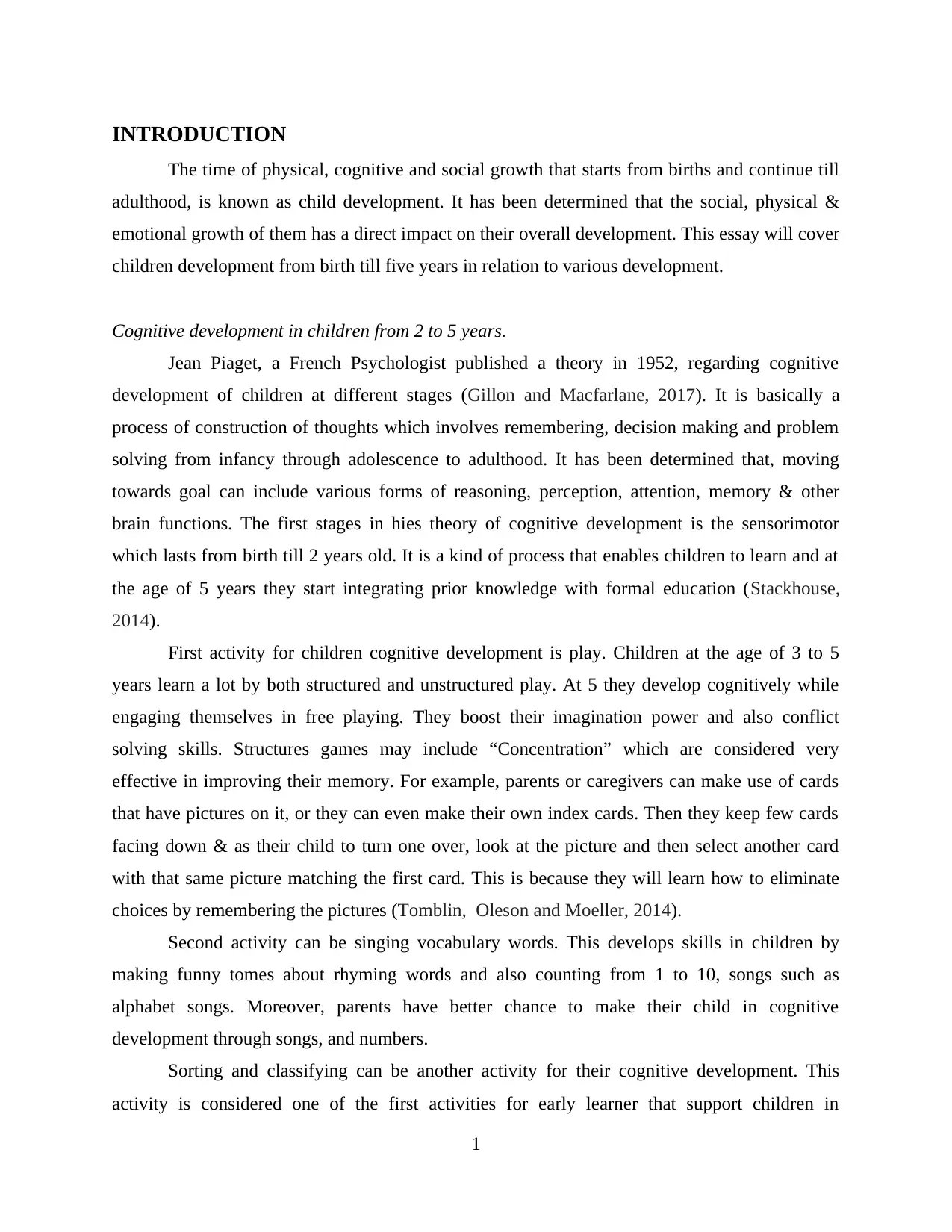
INTRODUCTION
The time of physical, cognitive and social growth that starts from births and continue till
adulthood, is known as child development. It has been determined that the social, physical &
emotional growth of them has a direct impact on their overall development. This essay will cover
children development from birth till five years in relation to various development.
Cognitive development in children from 2 to 5 years.
Jean Piaget, a French Psychologist published a theory in 1952, regarding cognitive
development of children at different stages (Gillon and Macfarlane, 2017). It is basically a
process of construction of thoughts which involves remembering, decision making and problem
solving from infancy through adolescence to adulthood. It has been determined that, moving
towards goal can include various forms of reasoning, perception, attention, memory & other
brain functions. The first stages in hies theory of cognitive development is the sensorimotor
which lasts from birth till 2 years old. It is a kind of process that enables children to learn and at
the age of 5 years they start integrating prior knowledge with formal education (Stackhouse,
2014).
First activity for children cognitive development is play. Children at the age of 3 to 5
years learn a lot by both structured and unstructured play. At 5 they develop cognitively while
engaging themselves in free playing. They boost their imagination power and also conflict
solving skills. Structures games may include “Concentration” which are considered very
effective in improving their memory. For example, parents or caregivers can make use of cards
that have pictures on it, or they can even make their own index cards. Then they keep few cards
facing down & as their child to turn one over, look at the picture and then select another card
with that same picture matching the first card. This is because they will learn how to eliminate
choices by remembering the pictures (Tomblin, Oleson and Moeller, 2014).
Second activity can be singing vocabulary words. This develops skills in children by
making funny tomes about rhyming words and also counting from 1 to 10, songs such as
alphabet songs. Moreover, parents have better chance to make their child in cognitive
development through songs, and numbers.
Sorting and classifying can be another activity for their cognitive development. This
activity is considered one of the first activities for early learner that support children in
1
The time of physical, cognitive and social growth that starts from births and continue till
adulthood, is known as child development. It has been determined that the social, physical &
emotional growth of them has a direct impact on their overall development. This essay will cover
children development from birth till five years in relation to various development.
Cognitive development in children from 2 to 5 years.
Jean Piaget, a French Psychologist published a theory in 1952, regarding cognitive
development of children at different stages (Gillon and Macfarlane, 2017). It is basically a
process of construction of thoughts which involves remembering, decision making and problem
solving from infancy through adolescence to adulthood. It has been determined that, moving
towards goal can include various forms of reasoning, perception, attention, memory & other
brain functions. The first stages in hies theory of cognitive development is the sensorimotor
which lasts from birth till 2 years old. It is a kind of process that enables children to learn and at
the age of 5 years they start integrating prior knowledge with formal education (Stackhouse,
2014).
First activity for children cognitive development is play. Children at the age of 3 to 5
years learn a lot by both structured and unstructured play. At 5 they develop cognitively while
engaging themselves in free playing. They boost their imagination power and also conflict
solving skills. Structures games may include “Concentration” which are considered very
effective in improving their memory. For example, parents or caregivers can make use of cards
that have pictures on it, or they can even make their own index cards. Then they keep few cards
facing down & as their child to turn one over, look at the picture and then select another card
with that same picture matching the first card. This is because they will learn how to eliminate
choices by remembering the pictures (Tomblin, Oleson and Moeller, 2014).
Second activity can be singing vocabulary words. This develops skills in children by
making funny tomes about rhyming words and also counting from 1 to 10, songs such as
alphabet songs. Moreover, parents have better chance to make their child in cognitive
development through songs, and numbers.
Sorting and classifying can be another activity for their cognitive development. This
activity is considered one of the first activities for early learner that support children in
1
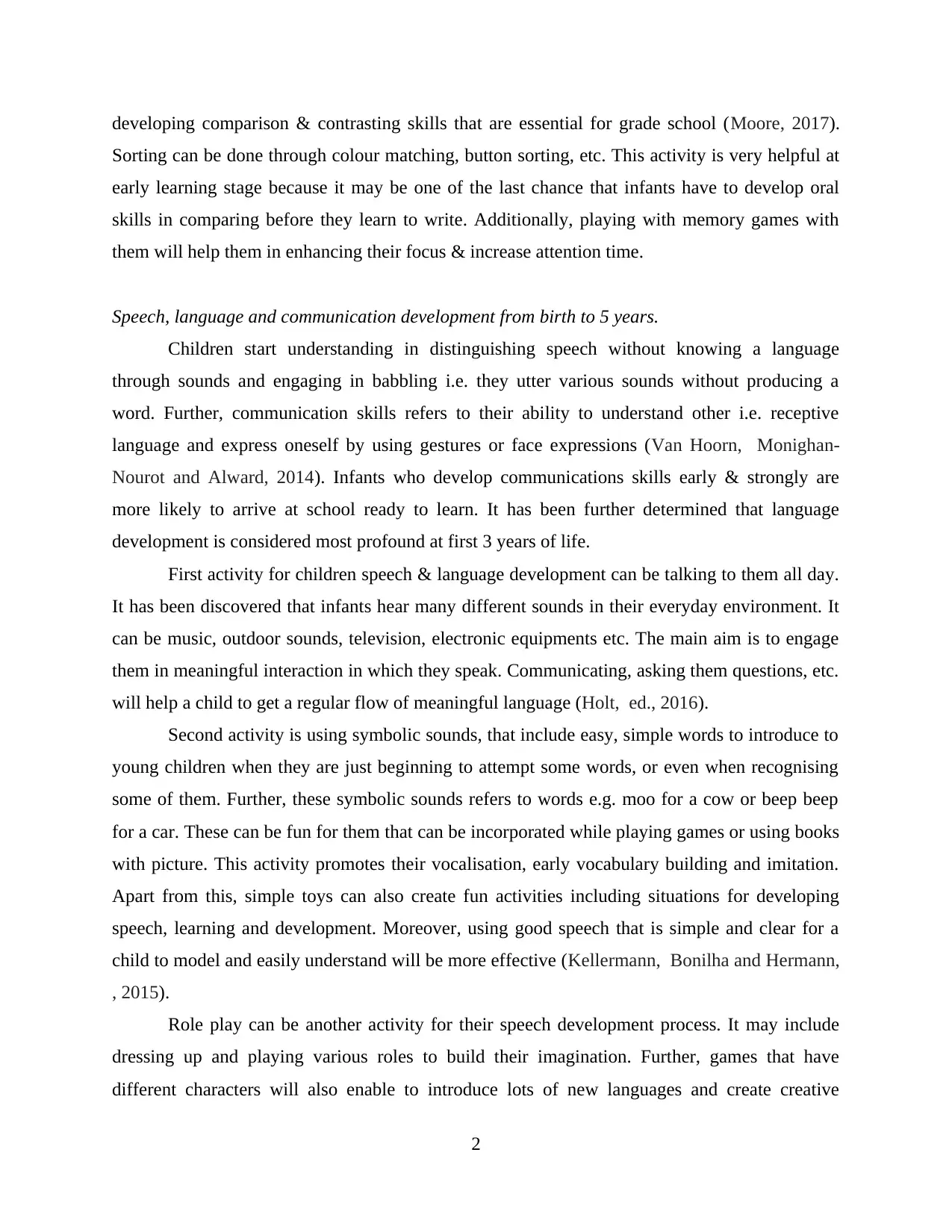
developing comparison & contrasting skills that are essential for grade school (Moore, 2017).
Sorting can be done through colour matching, button sorting, etc. This activity is very helpful at
early learning stage because it may be one of the last chance that infants have to develop oral
skills in comparing before they learn to write. Additionally, playing with memory games with
them will help them in enhancing their focus & increase attention time.
Speech, language and communication development from birth to 5 years.
Children start understanding in distinguishing speech without knowing a language
through sounds and engaging in babbling i.e. they utter various sounds without producing a
word. Further, communication skills refers to their ability to understand other i.e. receptive
language and express oneself by using gestures or face expressions (Van Hoorn, Monighan-
Nourot and Alward, 2014). Infants who develop communications skills early & strongly are
more likely to arrive at school ready to learn. It has been further determined that language
development is considered most profound at first 3 years of life.
First activity for children speech & language development can be talking to them all day.
It has been discovered that infants hear many different sounds in their everyday environment. It
can be music, outdoor sounds, television, electronic equipments etc. The main aim is to engage
them in meaningful interaction in which they speak. Communicating, asking them questions, etc.
will help a child to get a regular flow of meaningful language (Holt, ed., 2016).
Second activity is using symbolic sounds, that include easy, simple words to introduce to
young children when they are just beginning to attempt some words, or even when recognising
some of them. Further, these symbolic sounds refers to words e.g. moo for a cow or beep beep
for a car. These can be fun for them that can be incorporated while playing games or using books
with picture. This activity promotes their vocalisation, early vocabulary building and imitation.
Apart from this, simple toys can also create fun activities including situations for developing
speech, learning and development. Moreover, using good speech that is simple and clear for a
child to model and easily understand will be more effective (Kellermann, Bonilha and Hermann,
, 2015).
Role play can be another activity for their speech development process. It may include
dressing up and playing various roles to build their imagination. Further, games that have
different characters will also enable to introduce lots of new languages and create creative
2
Sorting can be done through colour matching, button sorting, etc. This activity is very helpful at
early learning stage because it may be one of the last chance that infants have to develop oral
skills in comparing before they learn to write. Additionally, playing with memory games with
them will help them in enhancing their focus & increase attention time.
Speech, language and communication development from birth to 5 years.
Children start understanding in distinguishing speech without knowing a language
through sounds and engaging in babbling i.e. they utter various sounds without producing a
word. Further, communication skills refers to their ability to understand other i.e. receptive
language and express oneself by using gestures or face expressions (Van Hoorn, Monighan-
Nourot and Alward, 2014). Infants who develop communications skills early & strongly are
more likely to arrive at school ready to learn. It has been further determined that language
development is considered most profound at first 3 years of life.
First activity for children speech & language development can be talking to them all day.
It has been discovered that infants hear many different sounds in their everyday environment. It
can be music, outdoor sounds, television, electronic equipments etc. The main aim is to engage
them in meaningful interaction in which they speak. Communicating, asking them questions, etc.
will help a child to get a regular flow of meaningful language (Holt, ed., 2016).
Second activity is using symbolic sounds, that include easy, simple words to introduce to
young children when they are just beginning to attempt some words, or even when recognising
some of them. Further, these symbolic sounds refers to words e.g. moo for a cow or beep beep
for a car. These can be fun for them that can be incorporated while playing games or using books
with picture. This activity promotes their vocalisation, early vocabulary building and imitation.
Apart from this, simple toys can also create fun activities including situations for developing
speech, learning and development. Moreover, using good speech that is simple and clear for a
child to model and easily understand will be more effective (Kellermann, Bonilha and Hermann,
, 2015).
Role play can be another activity for their speech development process. It may include
dressing up and playing various roles to build their imagination. Further, games that have
different characters will also enable to introduce lots of new languages and create creative
2
Secure Best Marks with AI Grader
Need help grading? Try our AI Grader for instant feedback on your assignments.
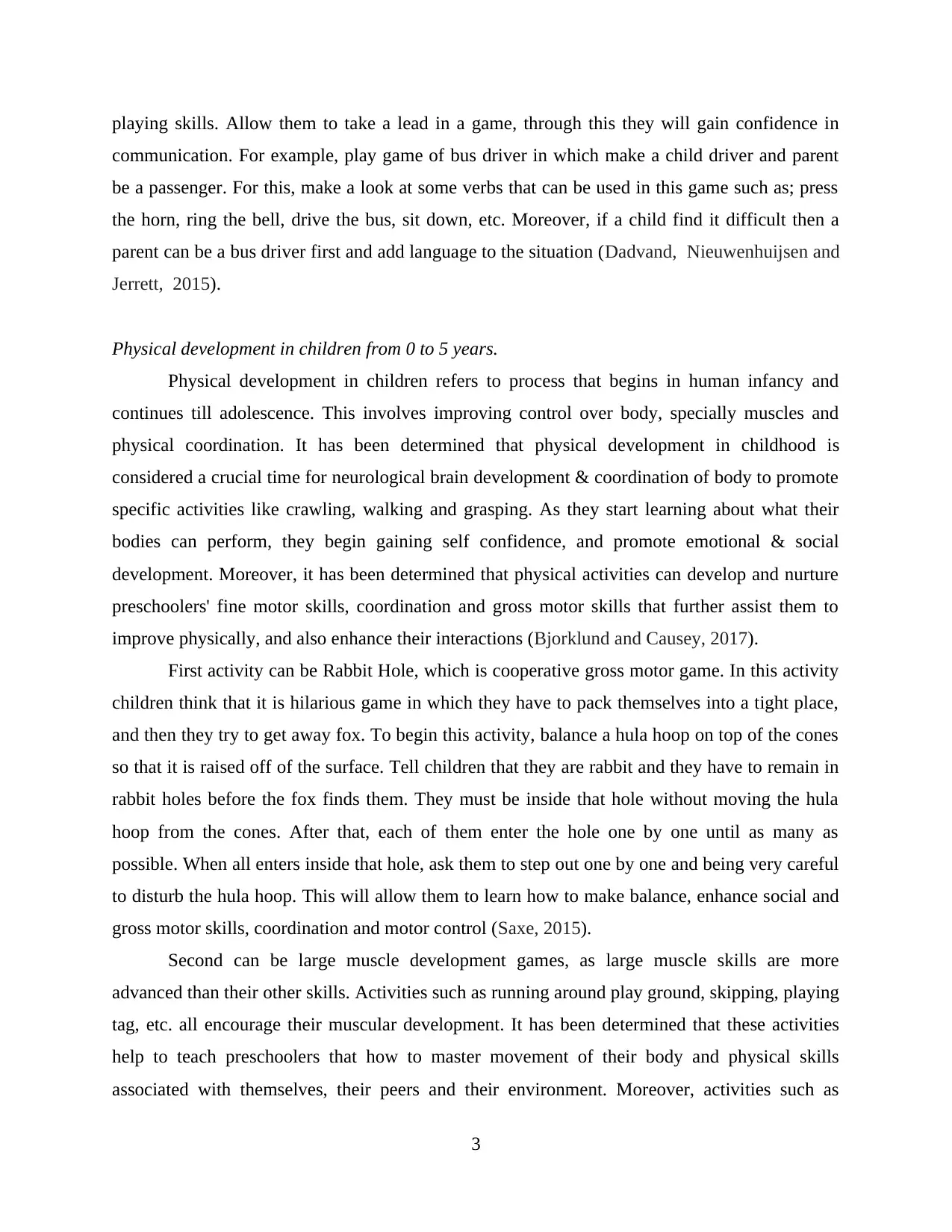
playing skills. Allow them to take a lead in a game, through this they will gain confidence in
communication. For example, play game of bus driver in which make a child driver and parent
be a passenger. For this, make a look at some verbs that can be used in this game such as; press
the horn, ring the bell, drive the bus, sit down, etc. Moreover, if a child find it difficult then a
parent can be a bus driver first and add language to the situation (Dadvand, Nieuwenhuijsen and
Jerrett, 2015).
Physical development in children from 0 to 5 years.
Physical development in children refers to process that begins in human infancy and
continues till adolescence. This involves improving control over body, specially muscles and
physical coordination. It has been determined that physical development in childhood is
considered a crucial time for neurological brain development & coordination of body to promote
specific activities like crawling, walking and grasping. As they start learning about what their
bodies can perform, they begin gaining self confidence, and promote emotional & social
development. Moreover, it has been determined that physical activities can develop and nurture
preschoolers' fine motor skills, coordination and gross motor skills that further assist them to
improve physically, and also enhance their interactions (Bjorklund and Causey, 2017).
First activity can be Rabbit Hole, which is cooperative gross motor game. In this activity
children think that it is hilarious game in which they have to pack themselves into a tight place,
and then they try to get away fox. To begin this activity, balance a hula hoop on top of the cones
so that it is raised off of the surface. Tell children that they are rabbit and they have to remain in
rabbit holes before the fox finds them. They must be inside that hole without moving the hula
hoop from the cones. After that, each of them enter the hole one by one until as many as
possible. When all enters inside that hole, ask them to step out one by one and being very careful
to disturb the hula hoop. This will allow them to learn how to make balance, enhance social and
gross motor skills, coordination and motor control (Saxe, 2015).
Second can be large muscle development games, as large muscle skills are more
advanced than their other skills. Activities such as running around play ground, skipping, playing
tag, etc. all encourage their muscular development. It has been determined that these activities
help to teach preschoolers that how to master movement of their body and physical skills
associated with themselves, their peers and their environment. Moreover, activities such as
3
communication. For example, play game of bus driver in which make a child driver and parent
be a passenger. For this, make a look at some verbs that can be used in this game such as; press
the horn, ring the bell, drive the bus, sit down, etc. Moreover, if a child find it difficult then a
parent can be a bus driver first and add language to the situation (Dadvand, Nieuwenhuijsen and
Jerrett, 2015).
Physical development in children from 0 to 5 years.
Physical development in children refers to process that begins in human infancy and
continues till adolescence. This involves improving control over body, specially muscles and
physical coordination. It has been determined that physical development in childhood is
considered a crucial time for neurological brain development & coordination of body to promote
specific activities like crawling, walking and grasping. As they start learning about what their
bodies can perform, they begin gaining self confidence, and promote emotional & social
development. Moreover, it has been determined that physical activities can develop and nurture
preschoolers' fine motor skills, coordination and gross motor skills that further assist them to
improve physically, and also enhance their interactions (Bjorklund and Causey, 2017).
First activity can be Rabbit Hole, which is cooperative gross motor game. In this activity
children think that it is hilarious game in which they have to pack themselves into a tight place,
and then they try to get away fox. To begin this activity, balance a hula hoop on top of the cones
so that it is raised off of the surface. Tell children that they are rabbit and they have to remain in
rabbit holes before the fox finds them. They must be inside that hole without moving the hula
hoop from the cones. After that, each of them enter the hole one by one until as many as
possible. When all enters inside that hole, ask them to step out one by one and being very careful
to disturb the hula hoop. This will allow them to learn how to make balance, enhance social and
gross motor skills, coordination and motor control (Saxe, 2015).
Second can be large muscle development games, as large muscle skills are more
advanced than their other skills. Activities such as running around play ground, skipping, playing
tag, etc. all encourage their muscular development. It has been determined that these activities
help to teach preschoolers that how to master movement of their body and physical skills
associated with themselves, their peers and their environment. Moreover, activities such as
3
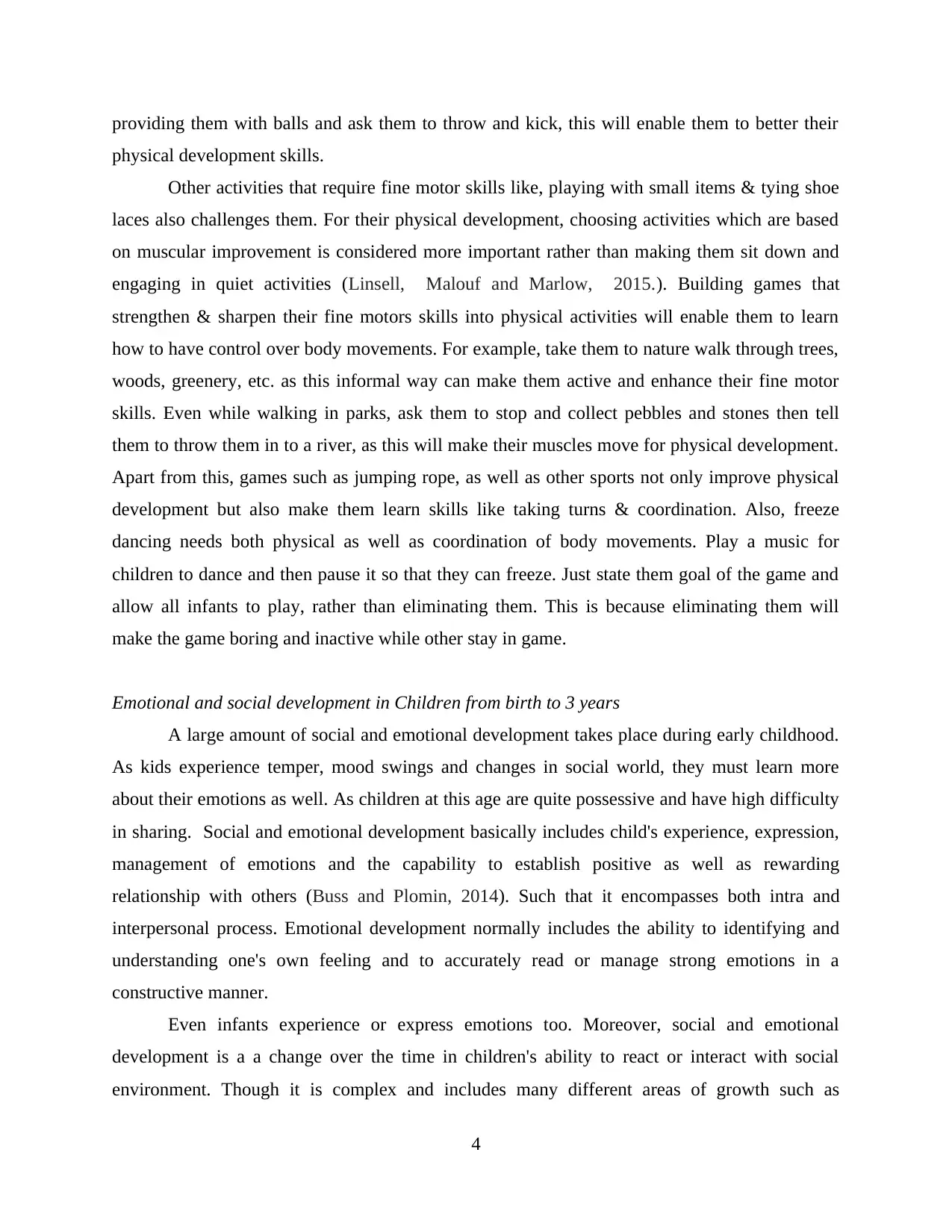
providing them with balls and ask them to throw and kick, this will enable them to better their
physical development skills.
Other activities that require fine motor skills like, playing with small items & tying shoe
laces also challenges them. For their physical development, choosing activities which are based
on muscular improvement is considered more important rather than making them sit down and
engaging in quiet activities (Linsell, Malouf and Marlow, 2015.). Building games that
strengthen & sharpen their fine motors skills into physical activities will enable them to learn
how to have control over body movements. For example, take them to nature walk through trees,
woods, greenery, etc. as this informal way can make them active and enhance their fine motor
skills. Even while walking in parks, ask them to stop and collect pebbles and stones then tell
them to throw them in to a river, as this will make their muscles move for physical development.
Apart from this, games such as jumping rope, as well as other sports not only improve physical
development but also make them learn skills like taking turns & coordination. Also, freeze
dancing needs both physical as well as coordination of body movements. Play a music for
children to dance and then pause it so that they can freeze. Just state them goal of the game and
allow all infants to play, rather than eliminating them. This is because eliminating them will
make the game boring and inactive while other stay in game.
Emotional and social development in Children from birth to 3 years
A large amount of social and emotional development takes place during early childhood.
As kids experience temper, mood swings and changes in social world, they must learn more
about their emotions as well. As children at this age are quite possessive and have high difficulty
in sharing. Social and emotional development basically includes child's experience, expression,
management of emotions and the capability to establish positive as well as rewarding
relationship with others (Buss and Plomin, 2014). Such that it encompasses both intra and
interpersonal process. Emotional development normally includes the ability to identifying and
understanding one's own feeling and to accurately read or manage strong emotions in a
constructive manner.
Even infants experience or express emotions too. Moreover, social and emotional
development is a a change over the time in children's ability to react or interact with social
environment. Though it is complex and includes many different areas of growth such as
4
physical development skills.
Other activities that require fine motor skills like, playing with small items & tying shoe
laces also challenges them. For their physical development, choosing activities which are based
on muscular improvement is considered more important rather than making them sit down and
engaging in quiet activities (Linsell, Malouf and Marlow, 2015.). Building games that
strengthen & sharpen their fine motors skills into physical activities will enable them to learn
how to have control over body movements. For example, take them to nature walk through trees,
woods, greenery, etc. as this informal way can make them active and enhance their fine motor
skills. Even while walking in parks, ask them to stop and collect pebbles and stones then tell
them to throw them in to a river, as this will make their muscles move for physical development.
Apart from this, games such as jumping rope, as well as other sports not only improve physical
development but also make them learn skills like taking turns & coordination. Also, freeze
dancing needs both physical as well as coordination of body movements. Play a music for
children to dance and then pause it so that they can freeze. Just state them goal of the game and
allow all infants to play, rather than eliminating them. This is because eliminating them will
make the game boring and inactive while other stay in game.
Emotional and social development in Children from birth to 3 years
A large amount of social and emotional development takes place during early childhood.
As kids experience temper, mood swings and changes in social world, they must learn more
about their emotions as well. As children at this age are quite possessive and have high difficulty
in sharing. Social and emotional development basically includes child's experience, expression,
management of emotions and the capability to establish positive as well as rewarding
relationship with others (Buss and Plomin, 2014). Such that it encompasses both intra and
interpersonal process. Emotional development normally includes the ability to identifying and
understanding one's own feeling and to accurately read or manage strong emotions in a
constructive manner.
Even infants experience or express emotions too. Moreover, social and emotional
development is a a change over the time in children's ability to react or interact with social
environment. Though it is complex and includes many different areas of growth such as
4
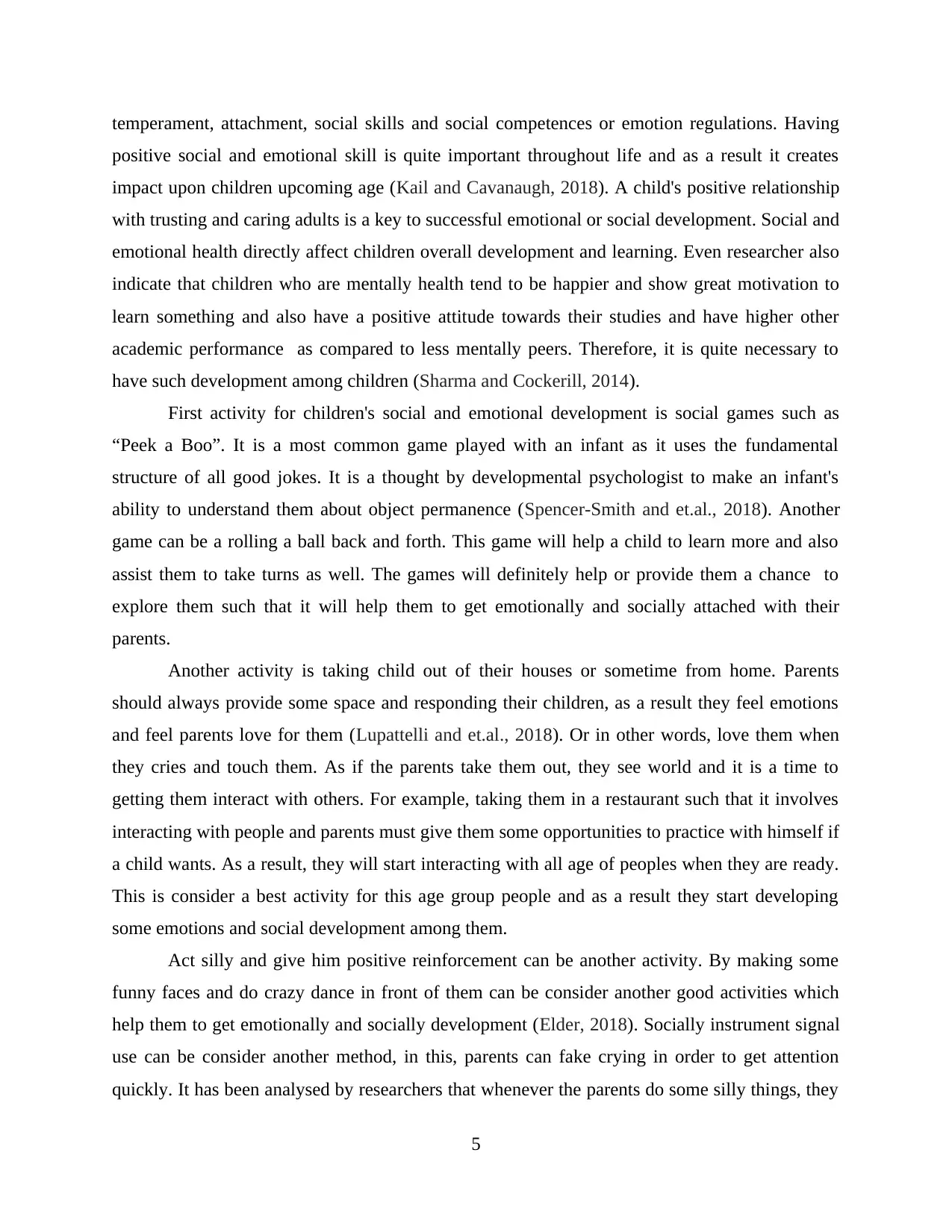
temperament, attachment, social skills and social competences or emotion regulations. Having
positive social and emotional skill is quite important throughout life and as a result it creates
impact upon children upcoming age (Kail and Cavanaugh, 2018). A child's positive relationship
with trusting and caring adults is a key to successful emotional or social development. Social and
emotional health directly affect children overall development and learning. Even researcher also
indicate that children who are mentally health tend to be happier and show great motivation to
learn something and also have a positive attitude towards their studies and have higher other
academic performance as compared to less mentally peers. Therefore, it is quite necessary to
have such development among children (Sharma and Cockerill, 2014).
First activity for children's social and emotional development is social games such as
“Peek a Boo”. It is a most common game played with an infant as it uses the fundamental
structure of all good jokes. It is a thought by developmental psychologist to make an infant's
ability to understand them about object permanence (Spencer-Smith and et.al., 2018). Another
game can be a rolling a ball back and forth. This game will help a child to learn more and also
assist them to take turns as well. The games will definitely help or provide them a chance to
explore them such that it will help them to get emotionally and socially attached with their
parents.
Another activity is taking child out of their houses or sometime from home. Parents
should always provide some space and responding their children, as a result they feel emotions
and feel parents love for them (Lupattelli and et.al., 2018). Or in other words, love them when
they cries and touch them. As if the parents take them out, they see world and it is a time to
getting them interact with others. For example, taking them in a restaurant such that it involves
interacting with people and parents must give them some opportunities to practice with himself if
a child wants. As a result, they will start interacting with all age of peoples when they are ready.
This is consider a best activity for this age group people and as a result they start developing
some emotions and social development among them.
Act silly and give him positive reinforcement can be another activity. By making some
funny faces and do crazy dance in front of them can be consider another good activities which
help them to get emotionally and socially development (Elder, 2018). Socially instrument signal
use can be consider another method, in this, parents can fake crying in order to get attention
quickly. It has been analysed by researchers that whenever the parents do some silly things, they
5
positive social and emotional skill is quite important throughout life and as a result it creates
impact upon children upcoming age (Kail and Cavanaugh, 2018). A child's positive relationship
with trusting and caring adults is a key to successful emotional or social development. Social and
emotional health directly affect children overall development and learning. Even researcher also
indicate that children who are mentally health tend to be happier and show great motivation to
learn something and also have a positive attitude towards their studies and have higher other
academic performance as compared to less mentally peers. Therefore, it is quite necessary to
have such development among children (Sharma and Cockerill, 2014).
First activity for children's social and emotional development is social games such as
“Peek a Boo”. It is a most common game played with an infant as it uses the fundamental
structure of all good jokes. It is a thought by developmental psychologist to make an infant's
ability to understand them about object permanence (Spencer-Smith and et.al., 2018). Another
game can be a rolling a ball back and forth. This game will help a child to learn more and also
assist them to take turns as well. The games will definitely help or provide them a chance to
explore them such that it will help them to get emotionally and socially attached with their
parents.
Another activity is taking child out of their houses or sometime from home. Parents
should always provide some space and responding their children, as a result they feel emotions
and feel parents love for them (Lupattelli and et.al., 2018). Or in other words, love them when
they cries and touch them. As if the parents take them out, they see world and it is a time to
getting them interact with others. For example, taking them in a restaurant such that it involves
interacting with people and parents must give them some opportunities to practice with himself if
a child wants. As a result, they will start interacting with all age of peoples when they are ready.
This is consider a best activity for this age group people and as a result they start developing
some emotions and social development among them.
Act silly and give him positive reinforcement can be another activity. By making some
funny faces and do crazy dance in front of them can be consider another good activities which
help them to get emotionally and socially development (Elder, 2018). Socially instrument signal
use can be consider another method, in this, parents can fake crying in order to get attention
quickly. It has been analysed by researchers that whenever the parents do some silly things, they
5
Paraphrase This Document
Need a fresh take? Get an instant paraphrase of this document with our AI Paraphraser
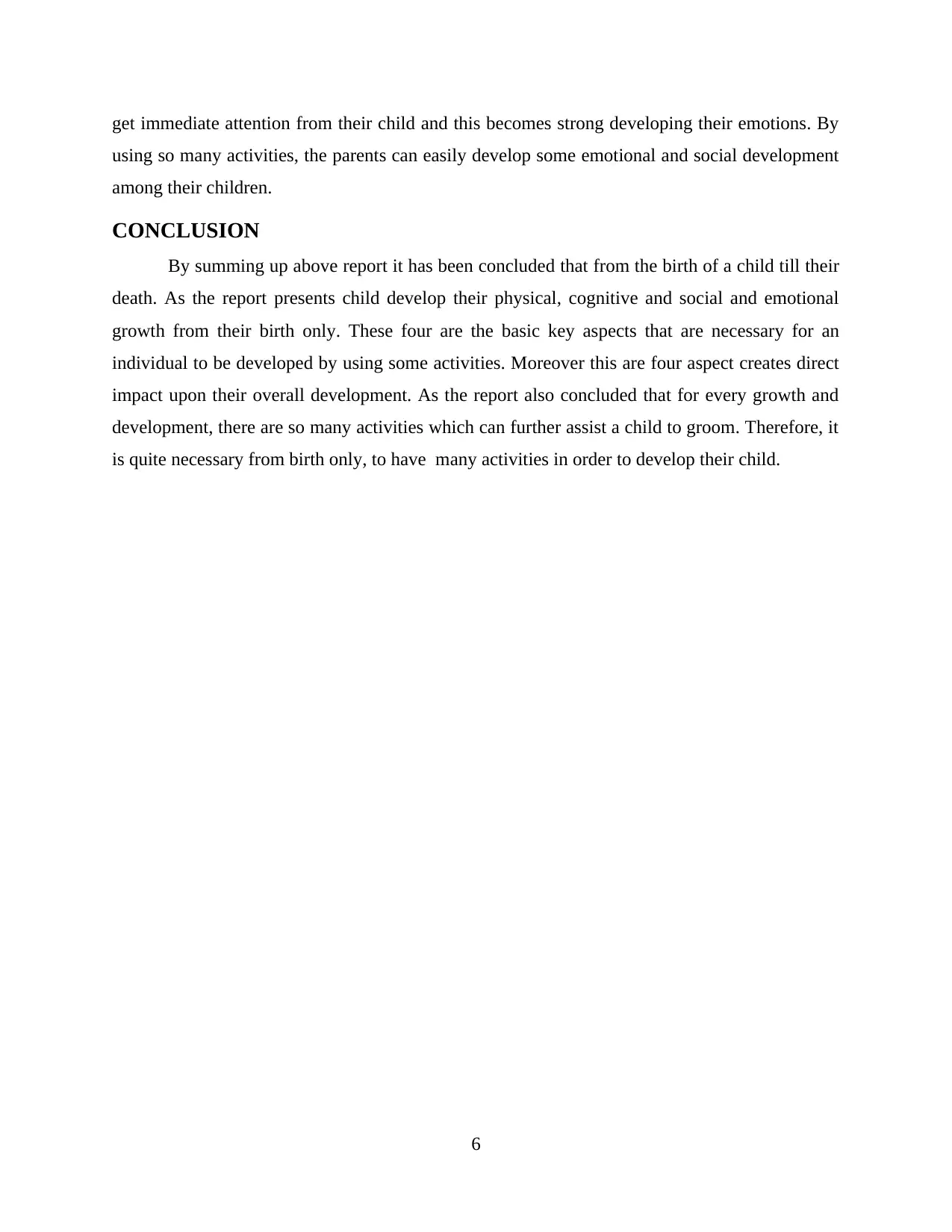
get immediate attention from their child and this becomes strong developing their emotions. By
using so many activities, the parents can easily develop some emotional and social development
among their children.
CONCLUSION
By summing up above report it has been concluded that from the birth of a child till their
death. As the report presents child develop their physical, cognitive and social and emotional
growth from their birth only. These four are the basic key aspects that are necessary for an
individual to be developed by using some activities. Moreover this are four aspect creates direct
impact upon their overall development. As the report also concluded that for every growth and
development, there are so many activities which can further assist a child to groom. Therefore, it
is quite necessary from birth only, to have many activities in order to develop their child.
6
using so many activities, the parents can easily develop some emotional and social development
among their children.
CONCLUSION
By summing up above report it has been concluded that from the birth of a child till their
death. As the report presents child develop their physical, cognitive and social and emotional
growth from their birth only. These four are the basic key aspects that are necessary for an
individual to be developed by using some activities. Moreover this are four aspect creates direct
impact upon their overall development. As the report also concluded that for every growth and
development, there are so many activities which can further assist a child to groom. Therefore, it
is quite necessary from birth only, to have many activities in order to develop their child.
6
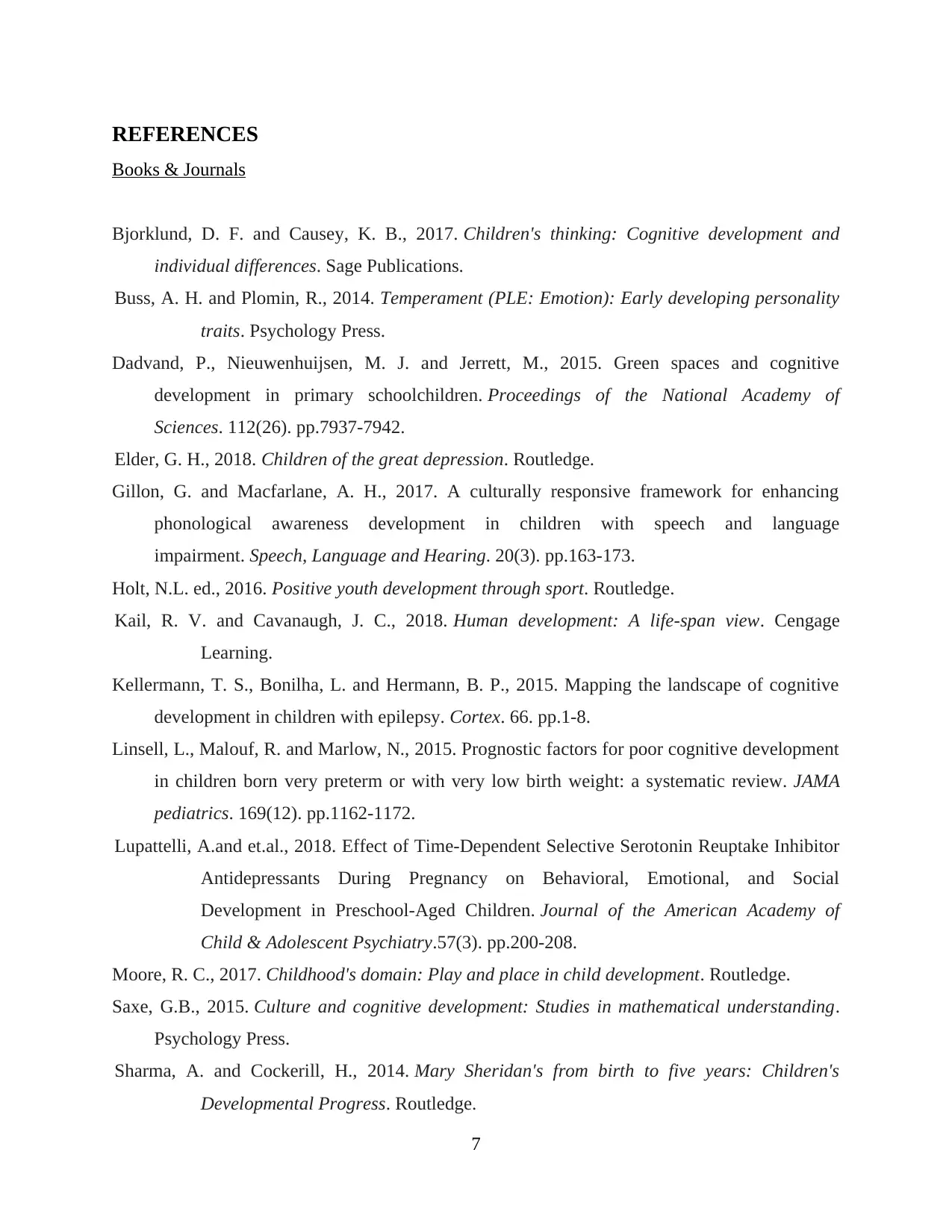
REFERENCES
Books & Journals
Bjorklund, D. F. and Causey, K. B., 2017. Children's thinking: Cognitive development and
individual differences. Sage Publications.
Buss, A. H. and Plomin, R., 2014. Temperament (PLE: Emotion): Early developing personality
traits. Psychology Press.
Dadvand, P., Nieuwenhuijsen, M. J. and Jerrett, M., 2015. Green spaces and cognitive
development in primary schoolchildren. Proceedings of the National Academy of
Sciences. 112(26). pp.7937-7942.
Elder, G. H., 2018. Children of the great depression. Routledge.
Gillon, G. and Macfarlane, A. H., 2017. A culturally responsive framework for enhancing
phonological awareness development in children with speech and language
impairment. Speech, Language and Hearing. 20(3). pp.163-173.
Holt, N.L. ed., 2016. Positive youth development through sport. Routledge.
Kail, R. V. and Cavanaugh, J. C., 2018. Human development: A life-span view. Cengage
Learning.
Kellermann, T. S., Bonilha, L. and Hermann, B. P., 2015. Mapping the landscape of cognitive
development in children with epilepsy. Cortex. 66. pp.1-8.
Linsell, L., Malouf, R. and Marlow, N., 2015. Prognostic factors for poor cognitive development
in children born very preterm or with very low birth weight: a systematic review. JAMA
pediatrics. 169(12). pp.1162-1172.
Lupattelli, A.and et.al., 2018. Effect of Time-Dependent Selective Serotonin Reuptake Inhibitor
Antidepressants During Pregnancy on Behavioral, Emotional, and Social
Development in Preschool-Aged Children. Journal of the American Academy of
Child & Adolescent Psychiatry.57(3). pp.200-208.
Moore, R. C., 2017. Childhood's domain: Play and place in child development. Routledge.
Saxe, G.B., 2015. Culture and cognitive development: Studies in mathematical understanding.
Psychology Press.
Sharma, A. and Cockerill, H., 2014. Mary Sheridan's from birth to five years: Children's
Developmental Progress. Routledge.
7
Books & Journals
Bjorklund, D. F. and Causey, K. B., 2017. Children's thinking: Cognitive development and
individual differences. Sage Publications.
Buss, A. H. and Plomin, R., 2014. Temperament (PLE: Emotion): Early developing personality
traits. Psychology Press.
Dadvand, P., Nieuwenhuijsen, M. J. and Jerrett, M., 2015. Green spaces and cognitive
development in primary schoolchildren. Proceedings of the National Academy of
Sciences. 112(26). pp.7937-7942.
Elder, G. H., 2018. Children of the great depression. Routledge.
Gillon, G. and Macfarlane, A. H., 2017. A culturally responsive framework for enhancing
phonological awareness development in children with speech and language
impairment. Speech, Language and Hearing. 20(3). pp.163-173.
Holt, N.L. ed., 2016. Positive youth development through sport. Routledge.
Kail, R. V. and Cavanaugh, J. C., 2018. Human development: A life-span view. Cengage
Learning.
Kellermann, T. S., Bonilha, L. and Hermann, B. P., 2015. Mapping the landscape of cognitive
development in children with epilepsy. Cortex. 66. pp.1-8.
Linsell, L., Malouf, R. and Marlow, N., 2015. Prognostic factors for poor cognitive development
in children born very preterm or with very low birth weight: a systematic review. JAMA
pediatrics. 169(12). pp.1162-1172.
Lupattelli, A.and et.al., 2018. Effect of Time-Dependent Selective Serotonin Reuptake Inhibitor
Antidepressants During Pregnancy on Behavioral, Emotional, and Social
Development in Preschool-Aged Children. Journal of the American Academy of
Child & Adolescent Psychiatry.57(3). pp.200-208.
Moore, R. C., 2017. Childhood's domain: Play and place in child development. Routledge.
Saxe, G.B., 2015. Culture and cognitive development: Studies in mathematical understanding.
Psychology Press.
Sharma, A. and Cockerill, H., 2014. Mary Sheridan's from birth to five years: Children's
Developmental Progress. Routledge.
7
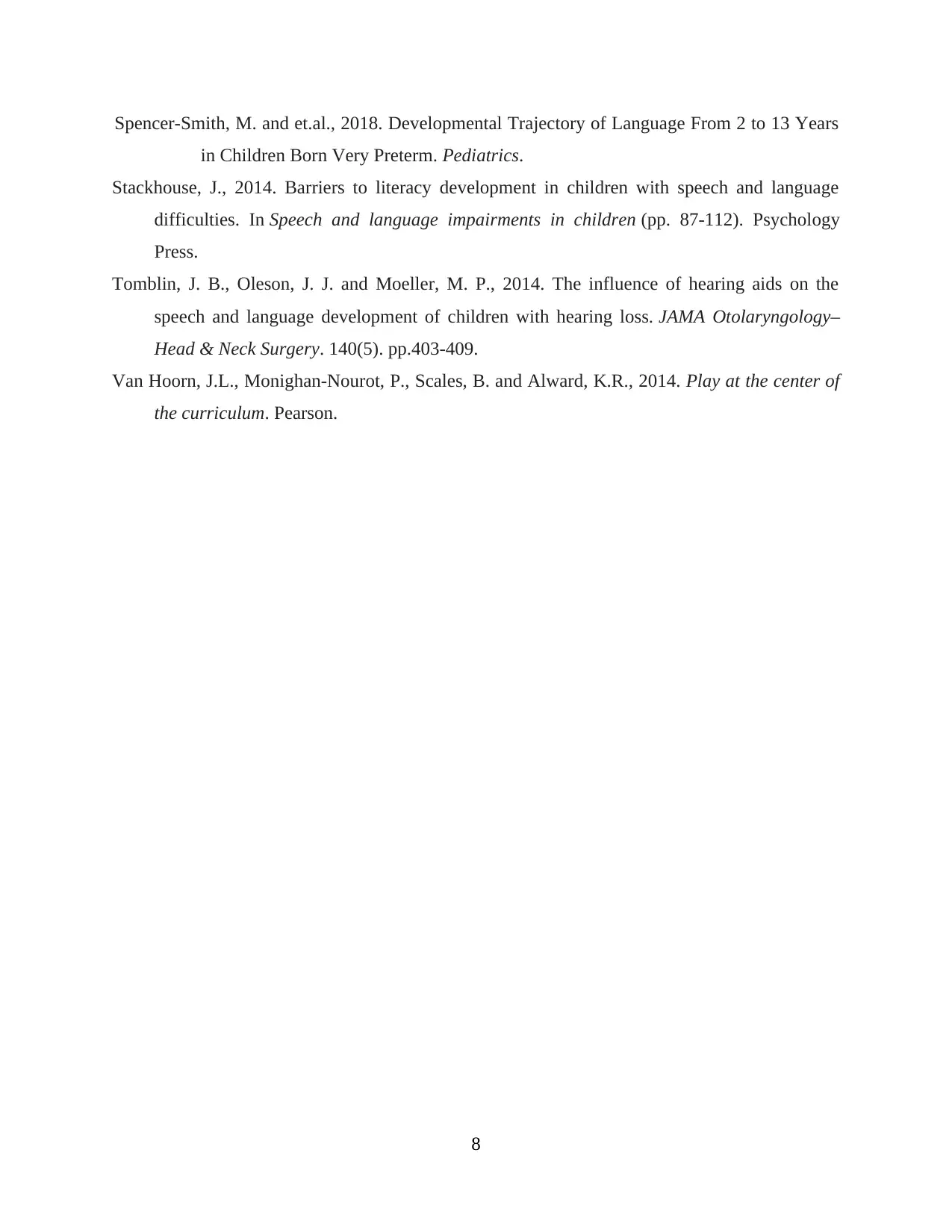
Spencer-Smith, M. and et.al., 2018. Developmental Trajectory of Language From 2 to 13 Years
in Children Born Very Preterm. Pediatrics.
Stackhouse, J., 2014. Barriers to literacy development in children with speech and language
difficulties. In Speech and language impairments in children (pp. 87-112). Psychology
Press.
Tomblin, J. B., Oleson, J. J. and Moeller, M. P., 2014. The influence of hearing aids on the
speech and language development of children with hearing loss. JAMA Otolaryngology–
Head & Neck Surgery. 140(5). pp.403-409.
Van Hoorn, J.L., Monighan-Nourot, P., Scales, B. and Alward, K.R., 2014. Play at the center of
the curriculum. Pearson.
8
in Children Born Very Preterm. Pediatrics.
Stackhouse, J., 2014. Barriers to literacy development in children with speech and language
difficulties. In Speech and language impairments in children (pp. 87-112). Psychology
Press.
Tomblin, J. B., Oleson, J. J. and Moeller, M. P., 2014. The influence of hearing aids on the
speech and language development of children with hearing loss. JAMA Otolaryngology–
Head & Neck Surgery. 140(5). pp.403-409.
Van Hoorn, J.L., Monighan-Nourot, P., Scales, B. and Alward, K.R., 2014. Play at the center of
the curriculum. Pearson.
8
1 out of 10
Related Documents
Your All-in-One AI-Powered Toolkit for Academic Success.
+13062052269
info@desklib.com
Available 24*7 on WhatsApp / Email
![[object Object]](/_next/static/media/star-bottom.7253800d.svg)
Unlock your academic potential
© 2024 | Zucol Services PVT LTD | All rights reserved.





